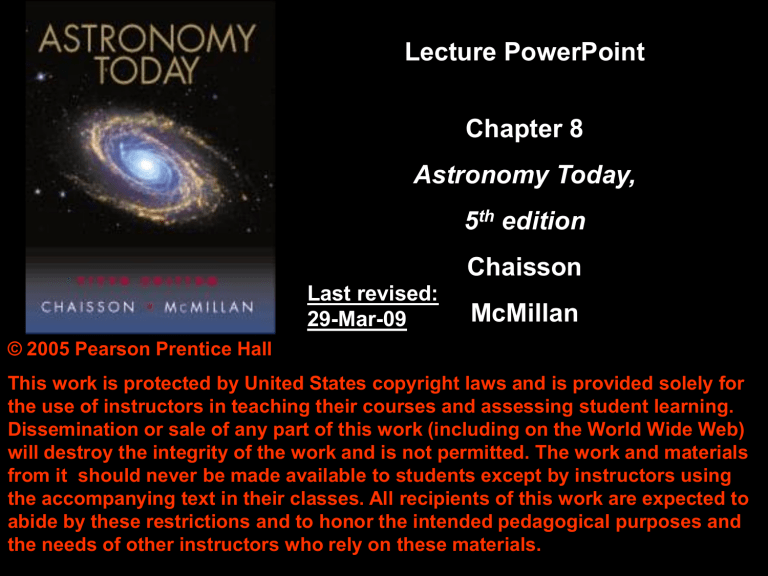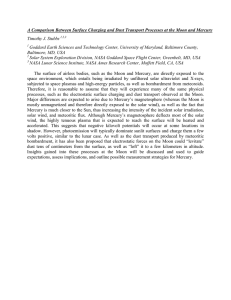Lecture PowerPoint Chapter 8 Chaisson McMillan

Lecture PowerPoint
Chapter 8
Astronomy Today,
5 th edition
Chaisson
Last revised:
29-Mar-09
McMillan
© 2005 Pearson Prentice Hall
This work is protected by United States copyright laws and is provided solely for the use of instructors in teaching their courses and assessing student learning.
Dissemination or sale of any part of this work (including on the World Wide Web) will destroy the integrity of the work and is not permitted. The work and materials from it should never be made available to students except by instructors using the accompanying text in their classes. All recipients of this work are expected to abide by these restrictions and to honor the intended pedagogical purposes and the needs of other instructors who rely on these materials.
Chapter 8
The Moon and Mercury
Moon Mercury
Mercury from Mariner 10
Mariner 10
Units of Chapter 8
Orbital Properties
Physical Properties
Surface Features on the Moon and Mercury
Rotation Rates
Lunar Exploration
Why Air Sticks Around
Lunar Cratering and Surface Composition
The Moon on a Shoestring
Units of Chapter 8, cont.
The Surface of Mercury
Interiors
The Origin of the Moon
Evolutionary History of the Moon and Mercury
8.1 Orbital Properties
Distance between Earth and Moon has been measured to accuracy of a few cm using lasers
Viewed from Earth, Mercury is never far from the Sun:
28 °
Laser Ranging of Moon from
McDonald Observatory
Retroreflectors on lunar suface left by the Apollo astronauts
Laser beam to the Moon to measure distance
8.1 Orbital Properties
Phases of Mercury can be seen best when
Mercury is at its maximum elongation :
8.2 Physical Properties
Moon Mercury Earth
Radius 1700 km 2440 km 6380 km
Mass 7.3 × 10 22 kg 3.3 × 10 23 kg 6.0 × 10 24 kg
Density 3300 kg/m 3 5400 kg/m 3 5500 kg/m 3
Escape
Speed
2.4 km/s 4.3 km/s 11.2 km/s
8.3 Surface Features on the Moon and Mercury
Moon has large dark flat areas, due to lava flow , called maria
(early observers thought they were oceans):
8.3 Surface Features on the Moon and Mercury
Moon also has many craters , from meteorite impacts:
8.3 Surface Features on the Moon and Mercury
Unknown what far side looked like until
Russian Luna 3 took first pictures
Sea of Moscow
Far side of Moon has some craters, but no very large maria:
8.3 Surface Features on the Moon and Mercury
Mercury cannot be imaged well from Earth; best pictures were from Mariner 10 until recently .
Cratering on
Mercury is similar to that on Moon:
8.4 Rotation Rates
Moon is tidally locked to Earth – its rotation rate is the same as the time it takes to make one revolution, so the same side of the Moon always faces Earth.
Mercury’s Period of Rotation
Determined using Arecibo Radio Telescope
Using Doppler Shifted Radio Waves
8.4 Rotation Rates
Mercury was long thought to be tidally locked to the
Sun; measurements in 1965 showed this to be false.
Rather, Mercury’s day and year are in a 3:2 resonance ; Mercury rotates three times while going around the Sun twice.
Why Do Atmospheres Stick Around Planets?
Molecules have kinetic speeds due to thermal motion (temperature) . If the average molecular speed is well below the escape velocity, few molecules will escape.
Escape becomes more probable:
• for lighter molecules since they have a higher speed for same kinetic energy v molecule
= [3 R T /M ] 1/2
( M is mol. wt.; R is gas const)
• at higher temperatures
• for smaller planets escape speed is less v esc
= [2GM planet
/R planet
] 1/2
8.5 Lunar Cratering and Surface Composition
Meteoroid strikes Moon, ejecting material; explosion ejects more material, leaving crater
8.5 Lunar Cratering and Surface Composition
• Craters are typically about 10 times as wide as the meteoroid creating them, and twice as deep.
• Rock is pulverized to a much greater depth.
• Most lunar craters date to at least 3.9 billion years ago; much less bombardment since then.
8.5 Lunar Cratering and Surface Composition
Regolith : thick layer of dust left by meteorite impacts
“Moonbuggy” tracks
Moon is still being bombarded, especially by very small
“ micrometeoroids ”; softens features:
8.5 Lunar Cratering and Surface Composition
Despite searches, no water ice has been found on Moon
(conflicting evidence on this)
62 mi.
Meteorites also hit Earth:
Manicouagan ,
Quebec
112 mi.
¾ mile
Barringer Crater
Chicxulub ,
Mexico
Bye, bye dinos
8.5 Lunar Cratering and Surface Composition
More than 3 billion years ago, the moon was volcanically active ; the rille here was formed then:
8.6 The Surface of Mercury
Mercury is less heavily cratered than the Moon
Some distinctive features:
Scarps (cliffs), several hundred km long and up to 3 km high
Caused by crustal shrinkage as it cooled
8.6 The Surface of Mercury
Caloris Basin a very large impact feature
Mariner 10
MESSENGER
Weird terrain found on opposite side of planet caused by seismic shock waves
Impact Basins in the Solar System
Mercury Moon Callisto
Caloris Mare Orientale Valhalla
Moon’s density is relatively low ( ρ = 3.35 g/cm 3 )
It has no active magnetic field so cannot have a large iron/nickel core
There is a “fossil” magnetic field from when interior was more molten
Crust is much thicker than Earth’s
Lunar Crust Thickness
The far side crust much thicker than the near side
This partially explains less maria on far side
Mercury is much denser than the Moon ( ρ = 5.427 g/cm 3 )
It has the largest relative core size of terrestrial planets
Big
It has a magnetic field - discovered by Mariner 10
Surprise!
Mercury’s Magnetosphere
Theories for Lunar Origin
• Fission
(mother-daughter)
• Capture
• Co-condensation
(co-accretion)
Evidence against:
Angular momentum
Statistical improbability
Density and elemental abundances
Catastrophe theories
• Interaction of planetesimals
• Ring ejection after large impact
Evidence for:
Density and elemental abundances
Computer modelling
8.8 The Origin of the Moon
Currently accepted theory of Moon’s origin : .
glancing impact of a Mars sized body on the still liquid Earth caused enough material, mostly from the mantle, to be ejected to form the Moon
Computer model:
Evolutionary History of the Moon
Time before present:
Event:
4.6 billion yr Formation of Moon; heavy bombardment liquefies surface crust forms
3.9 billion yr Bombardment much less intense; lunar volcanism fills maria
3.2 billion yr Volcanic activity ceases
Lunar Geologic History as Determined from Lunar Missions
Evolutionary History of Mercury
Mercury much less well understood
• Formed about 4.6 billion years ago
• Melted due to bombardment, cooled slowly
• Shrank , crumpling crust (creating scarps)
• Cratering from bombardment during same times as the Moon was being hit
Current/Future Missions
• US, Europe , India , Japan , China have active programs sending missions to the Moon
• MESSENGER Mission has just arrived at Mercury
• ESA planning BepiColombo mission
MESSENGER PICTURES
Differential forces
Tides
Tidal friction
Bay of Fundy
Tides
• Earth rotates every 24 hours
• Moon revolves once in a month
• Water bulge stays pointing towards Moon
• So the Earth’s surface rotates under the high water and low water points about every 6 hours
( high and low tides )
• There are also especially higher and lower tides caused by special alignments that include the
Sun’s tidal influences ( neap and spring tides next slide)
• There are also measurable land tides (a few cm
– first measured by Michelson with his interferometer)
The Sun has less effect, but it does modify the lunar tides
Spring tides (higher)
Earth Sun and Moon in a straight line
Neap tides (lower)
Earth, Sun and Moon make a right angle
Summary of Chapter 8
• Main surface features on Moon: maria, highlands (oldest parts-original crust)
• Both heavily cratered
• Both have extremely tiny atmospheres, and large day –night temperature excursions
• Tidal interactions responsible for synchronicity of Moon’s orbit (1:1), and resonance of Mercury’s
(3:2) [rev:rot]
Summary of Chapter 8, cont.
• Moon’s surface has both rocky and dusty material (regolith)
• Evidence for volcanic activity
• Mercury has no maria, but does have extensive intercrater plains and scarps



